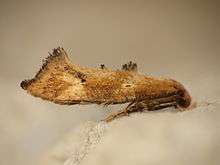Epermeniidae
| Epermeniidae | |
|---|---|
 | |
| Epermenia illigerella | |
| Scientific classification | |
| Kingdom: | Animalia |
| Phylum: | Arthropoda |
| Class: | Insecta |
| Order: | Lepidoptera |
| Suborder: | Glossata |
| Infraorder: | Heteroneura |
| (unranked): | Ditrysia |
| Superfamily: | Epermenioidea Minet, 1983 |
| Family: | Epermeniidae Spuler, 1910 |
| Diversity | |
| About 83 species | |
Epermeniidae or "fringe-tufted moths" is a family of insects in the lepidopteran order with about 14 genera. Previously they have been divided in two subfamilies Epermeniinae and Ochromolopinae (e.g. Common, 1990: 321) but this is no longer maintained since the last group is probably hierarchically nested within the first (Dugdale et al., 1999). They are presently placed in their own superfamily but have previously been placed among the Yponomeutoidea or Copromorphoidea with which some features are shared. Their systematic placement among the apoditrysian group "Obtectomera" (having pupal segments I-IV immobile) is however uncertain. They show some morphological similarities to the "plume moths" (Alucitoidea and Pterophoroidea), for example the wing fringe has similar groups of scales (Dugdale et al., 1999). There are also some similarities to Schreckensteinioidea, for example spiny legs and at least in some species an open-network cocoon. The genus Thambotricha from New Zealand may be the sister group of all other extant members. The most important genera are Epermenia, Ochromolopis and Gnathifera. The group has been extensively revised and catalogued by Dr Reinhard Gaedike (e.g. Gaedike, 1977, 1979).
- Disambiguation notes: Gnathifera Ahlrichs, 1995 (gnathiferans) is also the name of a superphylum. Chauliodus Bloch & Schneider, 1801 is a genus of viperfish.
Identification
Epermeniidae are small narrow-winged moths, 7-20 mm. in wingspan, with conspicuous whorls of bristles on their legs, lacking spines on the abdomen unlike some similar moths. The smoothly scaled head bears no ocelli or "chaetosemata". They can be most easily confused with Stathmopodinae (Oecophoridae), which unlike epermeniids have the tarsi of the forelegs and midlegs without the whorls of spines, and whose proboscis is scaled at the base (Robinson et al., 1994, for further details). The projecting scale tufts on the inner margin of the hindwing is the easiest field character (Common, 1990).
Distribution
Epermeniidae occur worldwide in both Temperate and Tropical regions where especially in montane areas (Robinson et al., 1994), but are sparsely known from the Afrotropics. Gnathifera occurs from Australia to New Caledonia; Epermenia ranges from the Palaearctic to Indo-Australia and the Pacific islands (Holloway et al., 2001).
Behaviour
Epermeniidae are nocturnal as adults and well-camouflaged. They rest parallel to the surface with their wings held over their back in a tent-like manner (Robinson et al., 1994).
Biology
The caterpillars feed inside almost any plant parts (fruits, seeds, galls, leaves or flowers), sometimes in a mine or sometimes exposed or under silk on the leaf surface; unlike some Lepidoptera the pupa is not extruded from the cocoon (Robinson et al., 1994) and may be found in its fine open-network cocoon on the plant or amongst debris on the ground (Common, 1990).
Hostplants
Many species in Europe feed on "umbels" Apiaceae, and Epermenia chaerophyllella is a pest of cultivated species (Dugdale et al., 1999). Other species feed on the parasitic plant families Santalaceae (e.g. the Australian "Quandong moth") and Loranthaceae, or on Pinaceae, Pittosporaceae and Leguminosae
Systematics
- Africepermenia Gaedike, 2004
- Agiton Turner, 1926
- Epermenia Hübner, 1825
- =Acanthedra Meyrick, 1917
- =Calotripis Hübner, 1825
- =Chauliodus Treitschke, 1833
- =Epermeniola Gaedike, 1968
- =Lophonotus Stephens, 1829
- =Tichotripis Hübner, 1825
- =Epimarptis Meyrick, 1914
- =Temeluchella Fletcher, 1940
- =Temelucha Meyrick, 1909
- =Cataplectica Walsingham, 1894
- =Heydenia Hofmann, 1868
- Gnathifera Gaedike, 1978
- Inuncus Gaedike, 2013
- Lasiostega Meyrick, 1932
- Mesepermenia Gaedike, 2004
- Notodryas Meyrick, 1897
- Ochromolopis Hübner, 1825
- Parochromolopis Gaedike, 1977
- Paraepermenia Gaedike, 1968
- Phaulernis Meyrick, 1895
- Picrodoxa Meyrick, 1923
- Sinicaepermenia Heppner, 1990
- Thambotricha Meyrick, 1922
References
- Common, I.F.B. (1990). Moths of Australia. Brill Academic Publishers, Leiden. 535 pages.
- Dugdale, J.S., Kristensen, N.P., Robinson, G.S. and Scoble, M.J. (1999) [1998]. The smaller microlepidoptera grade superfamilies, Ch.13., pp. 217-232 in Kristensen, N.P. (Ed.). Lepidoptera, Moths and Butterflies. Volume 1: Evolution, Systematics, and Biogeography. Handbuch der Zoologie. Eine Naturgeschichte der Stämme des Tierreiches / Handbook of Zoology. A Natural History of the phyla of the Animal Kingdom. Band / Volume IV Arthropoda: Insecta Teilband / Part 35: 491 pp. Walter de Gruyter, Berlin, New York.
- Gaedike, R. (1977). Revision der nearktischen und neotropischen Epermeniidae (Lepidoptera). Beiträge zur Entomologia, 27(2): 301-312.
- Gaedike, R. (1979). Katalog der Epermeniidae der Welt (Lepidoptera). Beiträge zur Entomologia, 29: 201-209.
- Holloway, J.D., Kibby, G and Peggie, D. (1997). The families of Malesian moths and butterflies. Fauna Malesia Handbooks. 455 pp. Brill Academic Publishers, Leiden.
- Robinson, G.S., Tuck, K.R., Shaffer, M. and Cook, K. (1994). The smaller moths of South-East Asia. Malaysian Nature Society, Kuala Lumpur.
Sources
- Firefly Encyclopedia of Insects and Spiders, edited by Christopher O'Toole, ISBN 1-55297-612-2, 2002
External links
- Tree of Life
- Natural History Museum hosts database
- UK leafmines
- UK Moths
- Moths of North Dakota
- Epermeniidae of Australia
- Quandong Moth Paraepermenia santaliella Gaedike, 1968
- Quandong Moth pdf
- Deltakey Epermeniidae
- Larvae from Stainton
- Wing venation
- Finnish species
- Lepidoptera of Tasmania
- New Zealand Thamnotricha vates
- Barcoding Progress
- Ochromolopis sp
- Markku Savela's website
| Wikispecies has information related to: Epermeniidae |